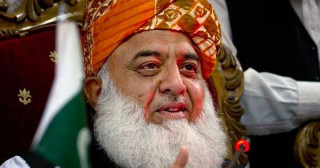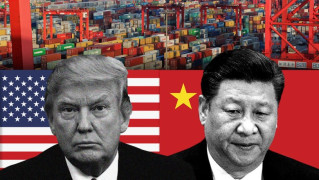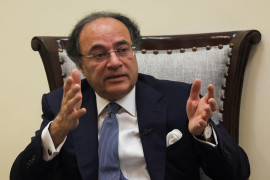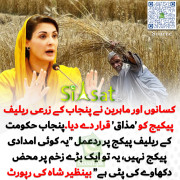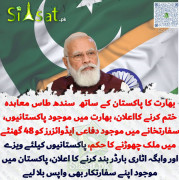Pakistan's Human Development in Musharraf Years- Highest in Pakistan's History
Pakistan's HDI grew an average rate of 2.7% per year under President Musharraf from 2000 to 2007, and then its pace slowed to 0.7% per year in 2008 to 2012 under elected politicians, according to the 2013 Human Development Report titled “The Rise of the South: Human Progress in a Diverse World”.
[TABLE="class: tr-caption-container, align: center"]
[TR]
[TD="align: center"] [/TD]
[/TD]
[/TR]
[TR]
[TD="class: tr-caption, align: center"]Source: Human Development Report 2013-Pakistan[/TD]
[/TR]
[/TABLE]
At 0.515, Pakistan's HDI is lower than the average HDI value of 0.558
for South Asia which is the second lowest among the various regions of the world tracked by UNDP. Between
2000 and 2012, the region registered annual growth of 1.43% in HDI
value, which is the highest of the regions. Afghanistan achieved the
fastest growth (3.9%), followed by Pakistan (1.7%) and India (1.5%),
according to the United Nations Development Program.
Overall, Pakistan's human development score rose by 18.9% during Musharraf years and increased just 3.4% under elected leadership since 2008. The news on the human development front got even worse in the last three years, with HDI growth slowing down as low as 0.59% — a paltry average annual increase of under 0.20 per cent.
Who's to blame for this dramatic slowdown in the nation's human development? Who gave it a low priority? Zardari? Peoples' Party? Sharif brothers? PML (N)? PML (Q)? Awami National Party? Muttahida Qaumi Movement? The answer is: All of them. They were all part of the government. In fact, the biggest share of the blame must be assigned to PML (N).
Sharif brothers weren't part of the ruling coalition at the center. So why should the PML (N) share the blame for falling growth in the nation's HDI? They must accept a large part of the blame because education and health, the biggest contributors to human development, are both provincial subjects and PML(N) was responsible for education and health care of more than half of Pakistan's population.
Going further back to the decade of 1990s when the civilian leadership of the country alternated between PML (N) and PPP, the increase in Pakistan's HDI was 9.3% from 1990 to 2000, less than half of the HDI gain of 18.9% on Musharraf's watch from 2000 to 2007.
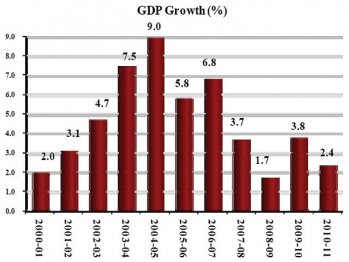
Acceleration of HDI growth during Musharraf years was not an accident. Not only did Musharraf's policies accelerate economic growth, helped create 13 million new jobs, cut poverty in half and halved the country's total debt burden in the period from 2000 to 2007, his government also ensured significant investment and focus on education and health care. In 2011, a Pakistani government commission on education found that public funding for education has been cut from 2.5% of GDP in 2007 to just 1.5% - less than the
annual subsidy given to the various PSUs including Pakistan Steel and PIA, both of which continue to sustain huge losses due to patronage-based hiring.
Looking at examples of nations such as the Asian Tigers which have achieved great success in the last few decades, the basic ingredient in each case has been large social sector investments they have made. It will be extremely difficult for Pakistan to catch up unless similar investments are made by Pakistani leaders.
As Pakistanis prepare to go to the polls on May 11, it is important that the voters demand an explanation from the incumbent political parties for their extremely poor performance in the social sector. Without accountability, these politicians will continue to ignore the badly needed investments required to develop the nation's human resources for a better tomorrow. Forcing the political leaders to prioritize social sector development is the best way to launch Pakistan on a faster trajectory.
SOURCE: http://www.pakalumni.com/profiles/blogs/pakistan-s-human-development-in-musharraf-years-highest-in-pakist
- Posted by Riaz Haq on March 31, 2013 at 6:30pm
- Send Message View Blog
Pakistan's HDI grew an average rate of 2.7% per year under President Musharraf from 2000 to 2007, and then its pace slowed to 0.7% per year in 2008 to 2012 under elected politicians, according to the 2013 Human Development Report titled “The Rise of the South: Human Progress in a Diverse World”.
[TABLE="class: tr-caption-container, align: center"]
[TR]
[TD="align: center"]
 [/TD]
[/TD][/TR]
[TR]
[TD="class: tr-caption, align: center"]Source: Human Development Report 2013-Pakistan[/TD]
[/TR]
[/TABLE]
At 0.515, Pakistan's HDI is lower than the average HDI value of 0.558
for South Asia which is the second lowest among the various regions of the world tracked by UNDP. Between
2000 and 2012, the region registered annual growth of 1.43% in HDI
value, which is the highest of the regions. Afghanistan achieved the
fastest growth (3.9%), followed by Pakistan (1.7%) and India (1.5%),
according to the United Nations Development Program.
Overall, Pakistan's human development score rose by 18.9% during Musharraf years and increased just 3.4% under elected leadership since 2008. The news on the human development front got even worse in the last three years, with HDI growth slowing down as low as 0.59% — a paltry average annual increase of under 0.20 per cent.
Who's to blame for this dramatic slowdown in the nation's human development? Who gave it a low priority? Zardari? Peoples' Party? Sharif brothers? PML (N)? PML (Q)? Awami National Party? Muttahida Qaumi Movement? The answer is: All of them. They were all part of the government. In fact, the biggest share of the blame must be assigned to PML (N).
Sharif brothers weren't part of the ruling coalition at the center. So why should the PML (N) share the blame for falling growth in the nation's HDI? They must accept a large part of the blame because education and health, the biggest contributors to human development, are both provincial subjects and PML(N) was responsible for education and health care of more than half of Pakistan's population.
Going further back to the decade of 1990s when the civilian leadership of the country alternated between PML (N) and PPP, the increase in Pakistan's HDI was 9.3% from 1990 to 2000, less than half of the HDI gain of 18.9% on Musharraf's watch from 2000 to 2007.

Acceleration of HDI growth during Musharraf years was not an accident. Not only did Musharraf's policies accelerate economic growth, helped create 13 million new jobs, cut poverty in half and halved the country's total debt burden in the period from 2000 to 2007, his government also ensured significant investment and focus on education and health care. In 2011, a Pakistani government commission on education found that public funding for education has been cut from 2.5% of GDP in 2007 to just 1.5% - less than the
annual subsidy given to the various PSUs including Pakistan Steel and PIA, both of which continue to sustain huge losses due to patronage-based hiring.
Looking at examples of nations such as the Asian Tigers which have achieved great success in the last few decades, the basic ingredient in each case has been large social sector investments they have made. It will be extremely difficult for Pakistan to catch up unless similar investments are made by Pakistani leaders.
As Pakistanis prepare to go to the polls on May 11, it is important that the voters demand an explanation from the incumbent political parties for their extremely poor performance in the social sector. Without accountability, these politicians will continue to ignore the badly needed investments required to develop the nation's human resources for a better tomorrow. Forcing the political leaders to prioritize social sector development is the best way to launch Pakistan on a faster trajectory.
SOURCE: http://www.pakalumni.com/profiles/blogs/pakistan-s-human-development-in-musharraf-years-highest-in-pakist
Last edited:


